Role of nitric oxide and prostanoids in the regulation of leg blood flow and blood pressure in humans with essential hypertension: effect of high-intensity aerobic training
- PMID: 22271868
- PMCID: PMC3382335
- DOI: 10.1113/jphysiol.2011.225136
Role of nitric oxide and prostanoids in the regulation of leg blood flow and blood pressure in humans with essential hypertension: effect of high-intensity aerobic training
Abstract
We examined the role of nitric oxide (NO) and prostanoids in the regulation of leg blood flow and systemic blood pressure before and after 8 weeks of aerobic high-intensity training in individuals with essential hypertension (n = 10) and matched healthy control subjects (n = 11). Hypertensive subjects were found to have a lower (P < 0.05) blood flow to the exercising leg than normotensive subjects (30 W: 2.92 ± 0.16 vs. 3.39 ± 0.37 l min(−1)). Despite the lower exercise hyperaemia, pharmacological inhibition of the NO and prostanoid systems reduced leg blood flow to a similar extent during exercise in the two groups and vascular relaxation to the NO-dependent vasodilator acetylcholine was also similar between groups. High-intensity aerobic training lowered (P < 0.05) resting systolic (∼9 mmHg) and diastolic (∼12 mmHg) blood pressure in subjects with essential hypertension, but this effect of training was abolished when the NO and prostanoid systems were inhibited. Skeletal muscle vascular endothelial NO synthase uncoupling, expression and phosphorylation status were similar in the two groups before and after training. These data demonstrate that a reduction in exercise hyperaemia in hypertensive subjects is not associated with a reduced capacity of the NO and prostanoid systems to induce vasodilatation or with altered acetylcholine-induced response. However, our data suggest that the observed reduction in blood pressure is related to a training-induced change in the tonic effect of NO and/or prostanoids on vascular tone.
Figures
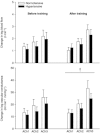
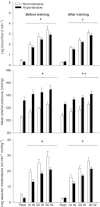
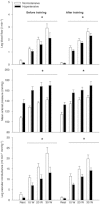
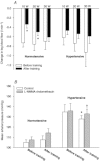
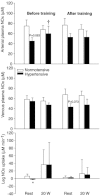
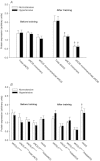
Similar articles
-
Prostaglandins do not contribute to the nitric oxide-mediated compensatory vasodilation in hypoperfused exercising muscle.Am J Physiol Heart Circ Physiol. 2011 Jul;301(1):H261-8. doi: 10.1152/ajpheart.00222.2011. Epub 2011 May 2. Am J Physiol Heart Circ Physiol. 2011. PMID: 21536852 Free PMC article.
-
Skeletal muscle blood flow and oxygen uptake at rest and during exercise in humans: a pet study with nitric oxide and cyclooxygenase inhibition.Am J Physiol Heart Circ Physiol. 2011 Apr;300(4):H1510-7. doi: 10.1152/ajpheart.00996.2010. Epub 2011 Jan 21. Am J Physiol Heart Circ Physiol. 2011. PMID: 21257921
-
Inhibition of nitric oxide and prostaglandins, but not endothelial-derived hyperpolarizing factors, reduces blood flow and aerobic energy turnover in the exercising human leg.J Physiol. 2007 Jun 1;581(Pt 2):853-61. doi: 10.1113/jphysiol.2006.127423. Epub 2007 Mar 8. J Physiol. 2007. PMID: 17347273 Free PMC article.
-
Possibility of leg muscle hypertrophy by ambulation in older adults: a brief review.Clin Interv Aging. 2013;8:369-75. doi: 10.2147/CIA.S43837. Epub 2013 Mar 31. Clin Interv Aging. 2013. PMID: 23573066 Free PMC article. Review.
-
Control of muscle blood flow during exercise: local factors and integrative mechanisms.Acta Physiol (Oxf). 2010 Aug;199(4):349-65. doi: 10.1111/j.1748-1716.2010.02129.x. Epub 2010 Mar 26. Acta Physiol (Oxf). 2010. PMID: 20353492 Free PMC article. Review.
Cited by
-
Skeletal muscle vasodilatation during maximal exercise in health and disease.J Physiol. 2012 Dec 15;590(24):6285-96. doi: 10.1113/jphysiol.2012.241190. Epub 2012 Oct 1. J Physiol. 2012. PMID: 23027820 Free PMC article. Review.
-
New conception for the development of hypertension in preeclampsia.Oncotarget. 2016 Nov 29;7(48):78387-78395. doi: 10.18632/oncotarget.13410. Oncotarget. 2016. PMID: 27861155 Free PMC article.
-
Reducing effect of aerobic exercise on blood pressure of essential hypertensive patients: A meta-analysis.Medicine (Baltimore). 2017 Mar;96(11):e6150. doi: 10.1097/MD.0000000000006150. Medicine (Baltimore). 2017. PMID: 28296729 Free PMC article.
-
The cardiovascular changes underlying a low cardiac output with exercise in patients with type 2 diabetes mellitus.Front Physiol. 2024 Mar 20;15:1294369. doi: 10.3389/fphys.2024.1294369. eCollection 2024. Front Physiol. 2024. PMID: 38571722 Free PMC article. Review.
-
Heart failure with preserved ejection fraction diminishes peripheral hemodynamics and accelerates exercise-induced neuromuscular fatigue.Am J Physiol Heart Circ Physiol. 2021 Jan 1;320(1):H338-H351. doi: 10.1152/ajpheart.00266.2020. Epub 2020 Nov 8. Am J Physiol Heart Circ Physiol. 2021. PMID: 33164549 Free PMC article.
References
-
- Bangsbo J, Gunnarson TP, Wendell J, Nybo L, Thomassen M. Reduced volume and increased training intensity elevate muscle Na+-K+ pump α-2-subunit expression as well as short- and long-term work capacity in humans. J Appl Physiol. 2009;107:1771–1780. - PubMed
-
- Calvert JW, Condit ME, Aragón JP, Nicholson CK, Moody BF, Hood RL, Sindler AL, Gundewar S, Seals DR, Barouch LA, Lefer DJ. Exercise protects against myocardial ischemia-reperfusion injury via stimulation of β3-adrenergic receptors and increased nitric oxide signaling: role of nitrite and nitrosothiols. Circ Res. 2011;108:1448–1458. - PMC - PubMed
-
- Cornelissen VA, Fagard RH. Effects of endurance training on blood pressure, blood pressure-regulating mechanisms, and cardiovascular risk factors. Hypertension. 2005;46:667–675. - PubMed
Publication types
MeSH terms
Substances
LinkOut - more resources
Full Text Sources
Medical
Miscellaneous

